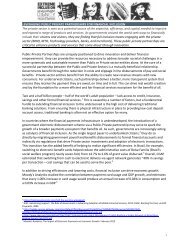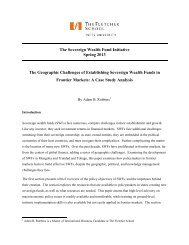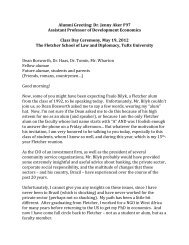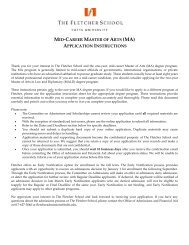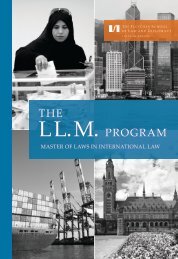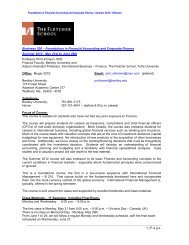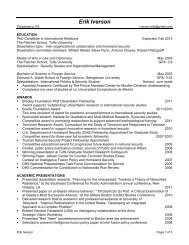dissertation prospectus guide - Fletcher School of Law and Diplomacy
dissertation prospectus guide - Fletcher School of Law and Diplomacy
dissertation prospectus guide - Fletcher School of Law and Diplomacy
You also want an ePaper? Increase the reach of your titles
YUMPU automatically turns print PDFs into web optimized ePapers that Google loves.
<strong>Fletcher</strong> Student Representatives to Ph.D. Committee, 19 July 2006DISSERTATION PROSPECTUS GUIDEThe outline below is for reference purposes only; sections may be presented in a different order,depending on the research (e.g., placing the literature review after methodology). Page-length<strong>guide</strong>lines may also vary, based on the requirements <strong>of</strong> your research <strong>and</strong>/or <strong>dissertation</strong>committee. All text should be fully cited with footnotes, endnotes or in-text, author-date formats.Please note, students engaging in business <strong>dissertation</strong>s may elect to write a three-essay<strong>dissertation</strong>, which has specific requirements not elaborated upon in this <strong>guide</strong>. Please contactyour advisor <strong>and</strong>/or the methodology pr<strong>of</strong>essor (Anna.Seleny@tufts.edu) for additionalinformation on that format or for additional guidance with your proposal.I. INTRODUCTION (2-3 double-spaced pages)A. PROBLEM STATEMENT (one to two pages)1. In one to two pages, describe a genuine problem in the world that your<strong>dissertation</strong> seeks address. Here, simply focus on defining this problem inorder to explain the relevancy <strong>of</strong> your research question. This part <strong>of</strong> theproposal should also address the “so what” test <strong>and</strong> should be clear to evennon-specialists.B. RESEARCH QUESTION AND HYPOTHESIS (one to three paragraphs or bullet points)1. Identify the primary question your <strong>dissertation</strong> poses, as well as anysubsidiary ones. Each should be clearly stated. You may choose to use thenotations Q 1 , Q 2 <strong>and</strong> Q 3 , etc., to make these distinctions. Often this is quitehelpful.2. Your primary research question should seek to address a genuine puzzle insocial science that stems from the problem statement above. If moreexplanation is needed, elaborate briefly on why your questions are puzzling;for example, you may choose to identify a bigger puzzle in the problemstatement, <strong>of</strong> which your question is only part.3. Your hypothesis is what you believe could be the answer to your primaryresearch question. If you have subsidiary questions, clearly state yourhypothesis for each. You may use the notations H 1 , H 2 <strong>and</strong> H 3 , etc., toidentify the various hypotheses for one or more questions.4. Present evidence on how you plan to test or falsify your hypotheses in thefollowing sections <strong>of</strong> your <strong>dissertation</strong> proposal: literature review,methodology, <strong>and</strong> information needs.Page 1 <strong>of</strong> 5
<strong>Fletcher</strong> Student Representatives to Ph.D. Committee, 19 July 2006II. FALSIFYING/TESTING YOUR HYPOTHESIS (10-20 double-spaced pages)A. LITERATURE REVIEW1. The purpose <strong>of</strong> this section is to demonstrate support for your hypothesis;i.e., show you know the literature in your fields as they pertain to your specificarea <strong>of</strong> research, to demonstrate that there is a gap in the literature that your<strong>dissertation</strong> seeks to address <strong>and</strong> thereby contribute to the field, <strong>and</strong> to falsifyyour research. Be sure to include citations in the literature review section <strong>of</strong>the proposal.2. Present major schools <strong>of</strong> thought on the issue you are exploring. Indicatewhether you are exploring the fields <strong>of</strong> political science, history, economics,law, business, sociology <strong>and</strong>/or anthropology. Please note that the <strong>Fletcher</strong>fields <strong>of</strong> security studies, conflict resolution, etc. are subfields <strong>of</strong> larger fields.3. This section should not be an overview <strong>of</strong> all the theories <strong>of</strong> the general topic<strong>of</strong> your <strong>dissertation</strong>. It is an opportunity to state how either the puzzle youidentify <strong>and</strong>/or research question has not been adequately addressed by theexisting theories/literature in various fields, or that the research has neverbeen done. If your research is breaking new ground, you must still presentthe various ways the research in your fields address the puzzle in order todemonstrate there is a gap.4. Present the differing hypotheses that have already been written by othersexploring the same problem <strong>and</strong> try to weave in your point <strong>of</strong> view. In otherwords, acknowledge what others have said; demonstrate what is lacking intheir analysis <strong>and</strong>/or what you are building upon; indicate how you agree <strong>and</strong>disagree with their work.5. Indicate when you conducted a <strong>dissertation</strong> abstract search. This may bedone by you or by one <strong>of</strong> the <strong>Fletcher</strong> Ginn librarians. Indicate who has donethe search, the dates the searches were done <strong>and</strong> the search terms used.You may use First Search on the Ginn A-Z journals <strong>and</strong> databases. If you findsimilar <strong>dissertation</strong>s, indicate how they are similar/different from yourproposal in the literature review section along with the other works you areevaluating, or indicate it when you discuss the dates, terms <strong>and</strong> person whoconducted the search.B. METHODOLOGY (THREE TO FIVE PAGES)1. Select the methodology that is most important/relevant to supporting yourhypothesis empirically <strong>and</strong> theoretically.a) You may employ more than one methodology.b) Indicate clearly on what basis you selected your methodology <strong>and</strong>how it best assists you in falsifying your hypothesis.Page 2 <strong>of</strong> 5
<strong>Fletcher</strong> Student Representatives to Ph.D. Committee, 19 July 2006c) If a particular methodology would be very suitable but is not possible,indicate this <strong>and</strong> explain why; (e.g., limitation <strong>of</strong> time, access todocuments/interviewees/respondents, lack <strong>of</strong> reliable data forquantitative, IRB restrictions, etc.).2. Indicate which methodology you plan to use.a) Specify if you will be employing qualitative, quantitative or bothapproaches <strong>and</strong> why.b) If using qualitative: Is this a single case study or multiple? If a single,how did you select this case? Can it be generalized to others? Ifmultiple, how do you account for case-selection bias? Are theycomparable cases, if so, on what criteria did you select them? Areyou using a historiography or process tracing? Will you be conductinginterviews or surveys? If so, who <strong>and</strong>/or how many will beinterviewed/surveyed? Will you have access to them? Do you havea questionnaire/survey – if so, provide it? What do you hope to gainfrom the interview/survey? How do you plan to select who will <strong>and</strong>won’t be interviewed/surveyed?c) If using quantitative: What databases will you be using <strong>and</strong>/orcreating? Are there any problems/gaps with the information? Will yoube running regressions? What specific statistical <strong>and</strong>/or economicformulas will you be employing?C. INFORMATION NEEDS1. This section details the applied steps for conducting your research asdictated by the methodology you select. It should be in paragraph format, notin list or bullet format.a) It is a detailed explanation <strong>of</strong> what you will need to do in order toobtain information (interviews, surveys, gathering data points, primary<strong>and</strong> secondary sources, travel, etc.).b) You should explain any special access you may have to documents,interviewees, respondents, etc., to demonstrate that it is feasible.2. Indicate how long you anticipate each step to take.D. CONCLUSION (FOUR TO FIVE SENTENCES)1. An excellent conclusion is essentially a restatement <strong>of</strong> the <strong>prospectus</strong> as awhole, not a restatement <strong>of</strong> the introduction, which presents the problem thatyou hope to address.2. An indication <strong>of</strong> how long you believe it will take you to complete your<strong>dissertation</strong>.Page 3 <strong>of</strong> 5
<strong>Fletcher</strong> Student Representatives to Ph.D. Committee, 19 July 2006III.OTHER REQUIREMENTSA. COVER PAGE1. Indicate clearly on your cover page the following items:a) Title <strong>of</strong> proposed <strong>dissertation</strong>.b) Your name <strong>and</strong> date <strong>of</strong> proposal defense.c) Name <strong>of</strong> the members on your committee.(1) In parentheses, indicate who is the chair, first reader, secondreader, etc., as well as their affiliation/school <strong>and</strong> department.(2) At least two readers must be from <strong>Fletcher</strong>. Provide CVs <strong>of</strong>other readers for the Ph.D. committee’s approval.2. Please note that changes to your committee <strong>and</strong>/or any change in your title(even one word) require that you receive approval <strong>of</strong> both your individualcommittee as well as the Ph.D. committee (via formal petition). Moderate tosubstantial changes in how you conduct your research may require approvalas well.B. EXECUTIVE SUMMARY1. Provide a one to two page, executive summary along with your proposal.This should clearly indicate your question(s), hypothesis <strong>and</strong> methodology. Itshould not be a repeat <strong>of</strong> your introduction, but rather a synthesis <strong>of</strong> theproposal.C. IRB EXEMPTION OR REVIEW1. Indicate clearly whether you have received IRB exemption or not. Providedates as well as a copy <strong>of</strong> the letter <strong>of</strong> exemption/approval. Forms <strong>and</strong>requirements are available on the Ph.D. website <strong>and</strong> through JeniferBurckett-Picker. All questions re IRB requirements <strong>and</strong> procedures at<strong>Fletcher</strong> should be addressed to her (Jenifer.Burckett-Picker@tufts.edu).D. ADDENDUM OF MODIFICATIONS FROM DISSERTATION PROPOSAL DEFENSE1. Incorporate any clarifications that may arise in the <strong>dissertation</strong> proposal oraldefense as an addendum to the proposal. This will save your time as well asthat <strong>of</strong> the Ph.D. committee in determining what topics have <strong>and</strong> have notbeen addressed at your proposal defense.E. PETITION FORM TO THE PH.D. COMMITTEE1. Download the appropriate petition form from the Ph.D. website.Page 4 <strong>of</strong> 5
<strong>Fletcher</strong> Student Representatives to Ph.D. Committee, 19 July 20062. Fill out the form, sign it <strong>and</strong> have your committee sign it following asuccessful <strong>dissertation</strong> proposal defense.3. Indicate whether or not the elected Ph.D. student representatives may view itin order to advocate on your behalf. If you elect this option, feel free tocontact them on any information you wish to clarify on your proposal beforethe committee meeting so that they may advocate on your behalf at themeeting.4. Submit the <strong>dissertation</strong> proposal petition form along with eight (8) hard copies<strong>of</strong> your <strong>dissertation</strong> proposal to Jenifer Burckett-Picker for dissemination tothe members <strong>of</strong> the Ph. D. committee. Attach any addendums <strong>and</strong>/or CVs <strong>of</strong>non-<strong>Fletcher</strong> readers on the committee. Alternatively, you may send yourproposal <strong>and</strong> post-proposal defense addendum via email to her attention(Jenifer.Burckett-Picker@tufts.edu) for electronic dissemination. If youchoose this option, hard copies <strong>of</strong> the petition form must be submitted by thedeadline to Jenifer Burckett-Picker. Please contact her directly forinformation on deadlines <strong>and</strong> scheduled Ph.D. committee meetings.5. Following the review <strong>of</strong> your proposal by the Ph.D. committee, either JeniferBurckett-Picker <strong>and</strong>/or the faculty chair <strong>of</strong> the Ph.D. committee will contactyou with comments from the committee. The committee may approve yourproposal, request clarifications/modifications, provide suggestions or rejectyour proposal. You may speak with the elected student members <strong>of</strong> thecommittee at any time regarding your proposal <strong>and</strong> comments you mayreceive.6. A list <strong>of</strong> the current members <strong>of</strong> the Ph.D. committee, as well as the electedstudent members is on the <strong>Fletcher</strong> Ph.D. website at the following link:http://fletcher.tufts.edu/phd/committee.html Please note that the faculty <strong>and</strong>student members change yearly. Student elections are held in springsemester <strong>and</strong> are announced on the listserv. Faculty appointments are selfselected<strong>and</strong> then appointed by the academic dean during the summer term<strong>and</strong> are announced at the beginning <strong>of</strong> fall semester.Page 5 <strong>of</strong> 5



